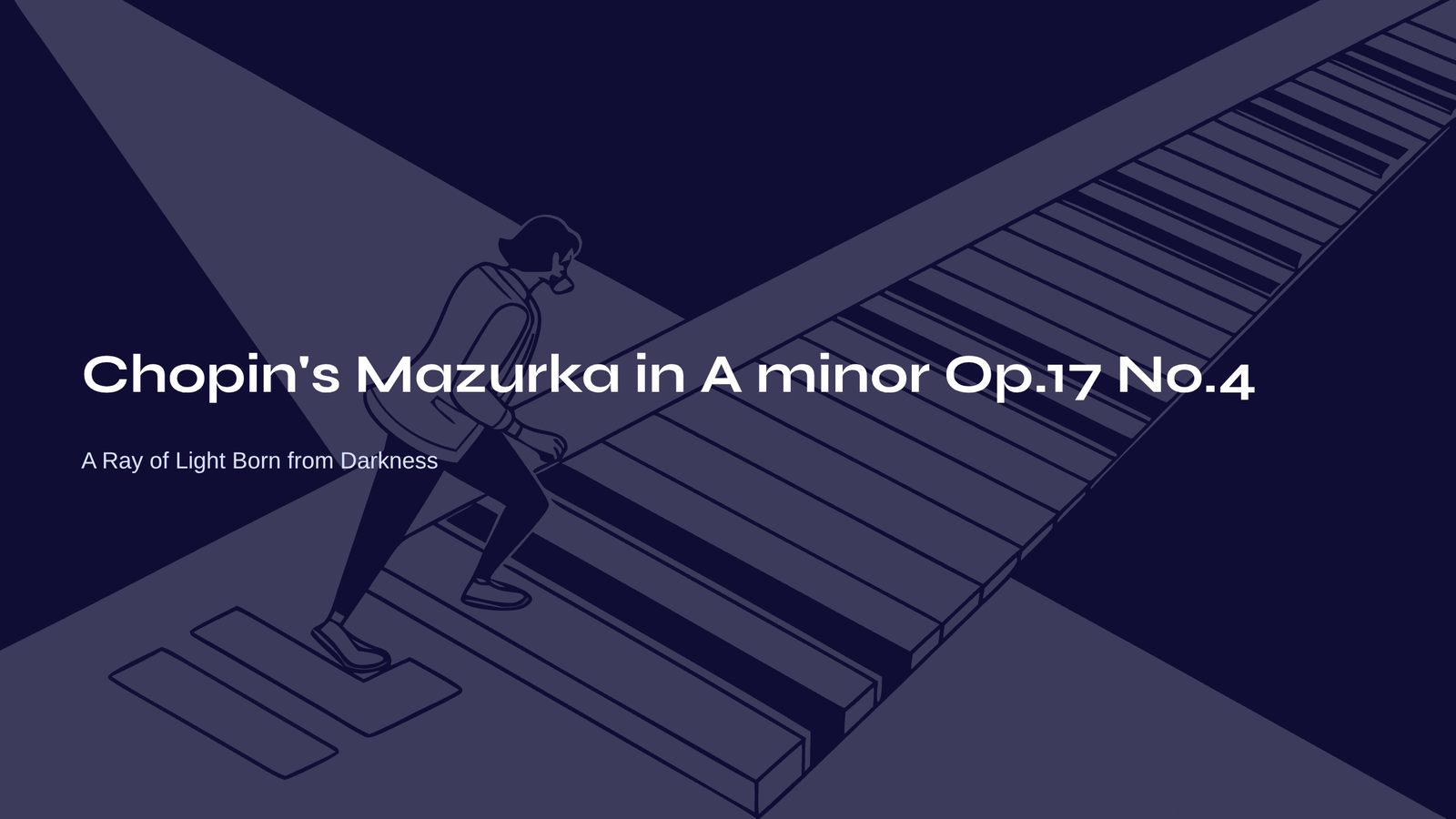Table of Contents

The Moment the First Key Sounded
Sitting at the piano and pressing the first note, it felt as if a Polish wind was blowing from somewhere. Chopin’s Mazurka in A minor Op.17 No.4 is precisely that kind of piece. Though it’s merely a 3-minute miniature, it contains within it all the longing for homeland, hope, and the light and shadow of life itself.
Have you ever experienced time standing still while listening to music? This mazurka casts exactly that kind of spell. The journey that begins in darkness, moves toward light, and returns again to quiet darkness feels like life itself.
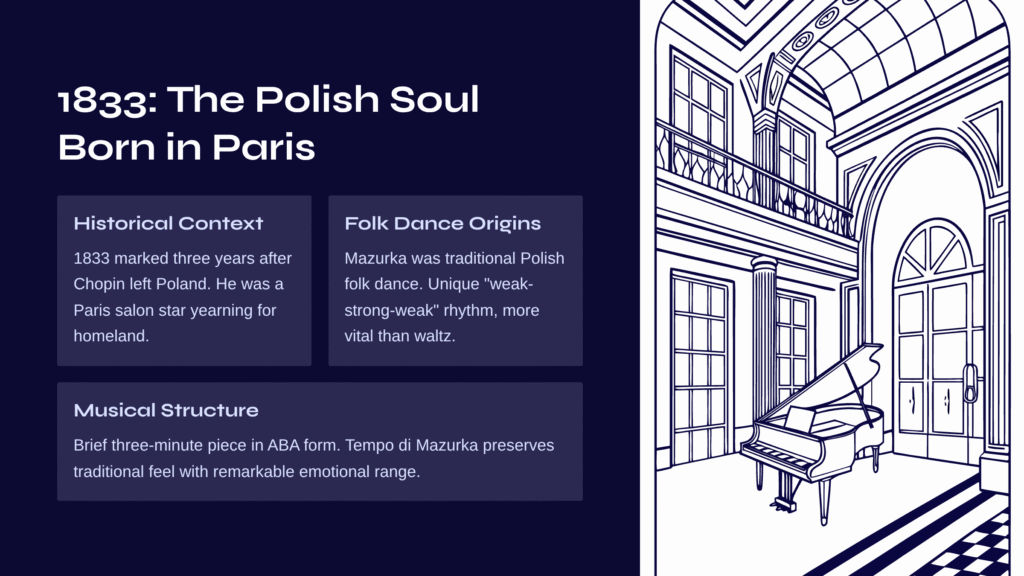
1833: The Polish Soul Born in Paris
The year 1833, when Chopin completed this mazurka, was special for him. Three years after leaving Poland to settle in Paris, he was already a star of the salons, yet also a young artist yearning for his homeland. All four mazurkas of Op.17 contain these complex emotions, with the fourth in A minor representing their pinnacle.
The mazurka was originally a traditional Polish folk dance. More rough-hewn and vital than the waltz, this dance possesses a unique rhythm of “weak-strong-weak” rather than “strong-weak-weak.” Chopin transported this rhythm to the piano keyboard, exquisitely combining salon elegance with Polish wildness.
Op.17 No.4 is a brief piece of about three minutes, yet within the clear structure of ABA form, it displays remarkable emotional undulations. The tempo marking “Tempo di Mazurka” indicates a moderate speed that preserves the traditional feel of the mazurka.
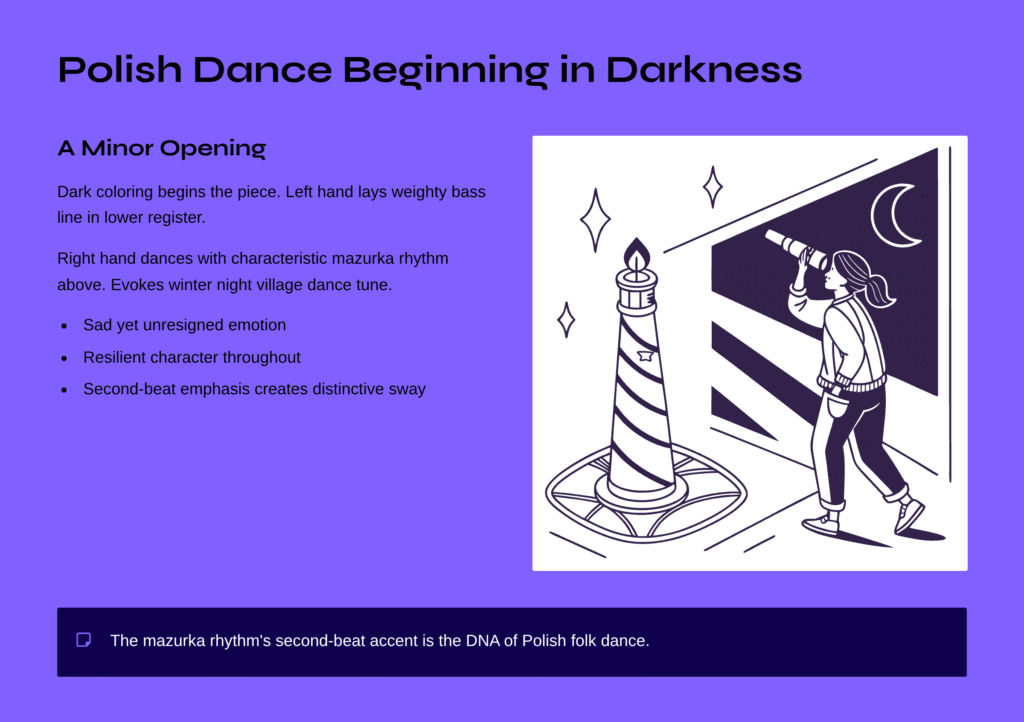
Polish Dance Beginning in Darkness
The opening A section begins with the dark coloring of A minor. The left hand lays down a weighty bass line in the lower register, while the right hand dances above it to the characteristic mazurka rhythm.
Listening to this section evokes a dance tune drifting from some Polish countryside village on a winter night. One can picture someone dancing alone in a small room where a single candle flickers. It’s sad yet unresigned, conveying a kind of resilience.
Particularly noteworthy is the mazurka rhythm’s “second-beat emphasis.” Unlike the typical waltz that places stress on the first beat, the mazurka gives a slight accent to the second beat, creating its distinctive sway. This is the very DNA of Polish folk dance.
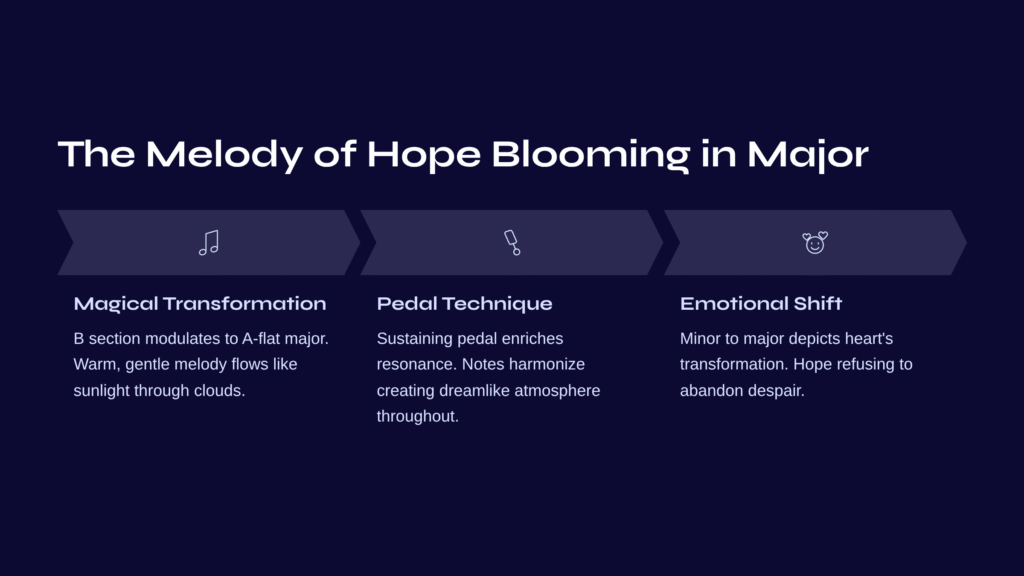
The Melody of Hope Blooming in Major
In the middle B section, the piece transforms as if by magic. Modulating to A-flat major, suddenly a warm and gentle melody flows forth. It’s like the moment sunlight filters through clouds.
Here, Chopin hints at the effective use of the pedal. Sustaining the pedal to enrich the resonance allows the notes to harmonize with each other, creating a dreamlike atmosphere. The left-hand accompaniment also becomes much softer than in the first section, while the right-hand melody sings as if someone were whispering.
Have you ever had a moment when you refused to abandon hope even in despair? Exactly such emotion is contained wholly in this middle section. The transition from minor to major is not merely a harmonic change, but a musical depiction of the heart’s transformation.
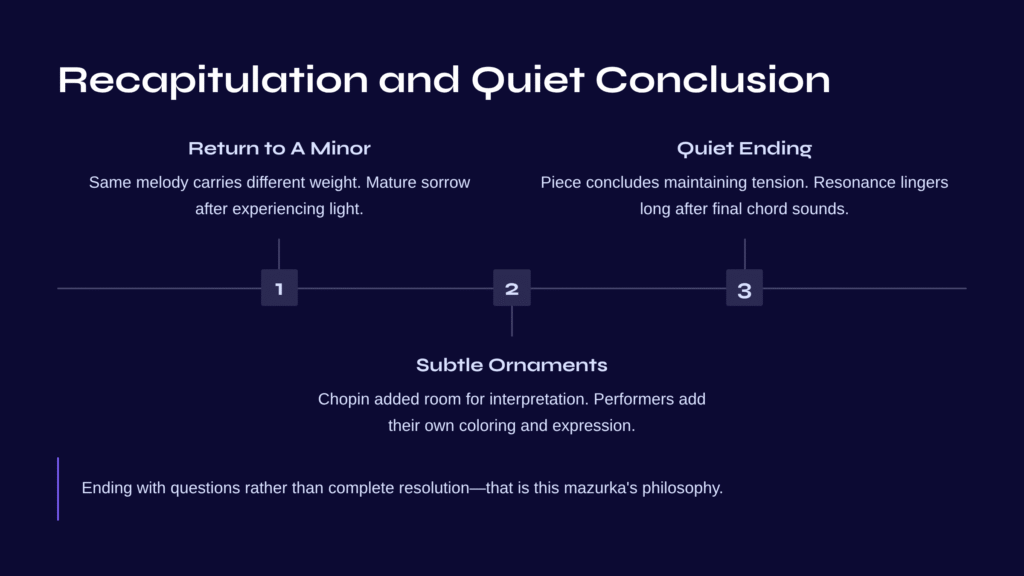
Recapitulation and Quiet Conclusion
When the A section returns in the recapitulation, it’s somehow different. Perhaps because it comes after experiencing the light of the middle section, the same A minor melody carries a different weight than the first time. It’s like the mature sorrow of someone who has returned after enduring hardship.
Chopin added subtle ornaments in this recapitulation, leaving room for performers to add their own coloring. Some performers express it more dramatically, others more introspectively. This very diversity of interpretation is the charm of Chopin’s music.
The piece concludes quietly while maintaining A minor’s tension. The resonance lingers long after the final chord sounds, which must be Chopin’s intention. Ending with questions rather than complete resolution—that is this mazurka’s philosophy.
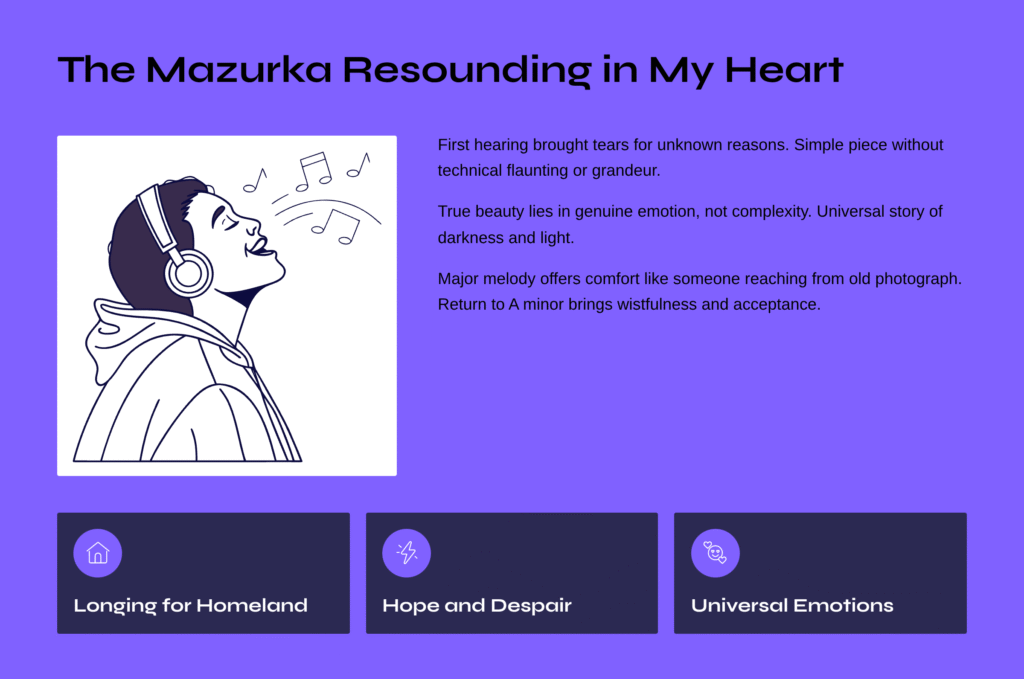
The Mazurka Resounding in My Heart
When I first heard this piece, tears came for reasons I couldn’t understand. It was a simple piece that neither flaunted technique nor was particularly grand. But as time passed, I realized that true beauty lies not in complexity, but in genuine emotion.
This mazurka is Chopin’s longing for his homeland and simultaneously the story of universal emotions we all possess. Could there be music that more accurately depicts the human heart’s movement between darkness and light, despair and hope?
Especially when the major melody of the middle section appears, it feels as if someone is reaching out from an old photograph to offer comfort. And when it returns to A minor, one feels both the wistfulness of returning to reality and the maturity of acceptance.
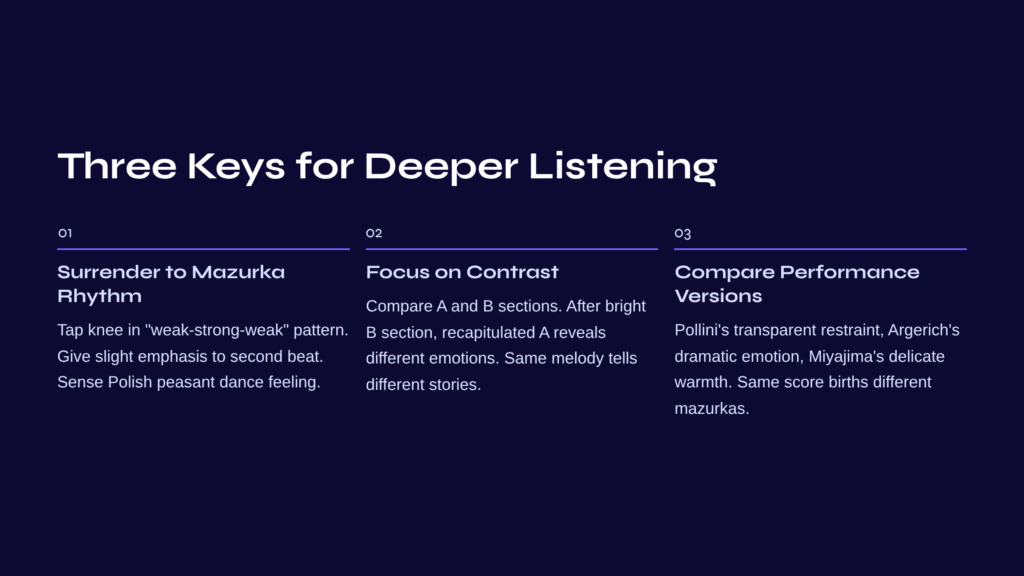
Three Keys for Deeper Listening
First, surrender yourself to the mazurka rhythm. Sit in your chair and lightly tap your knee in “weak-strong-weak” pattern, giving slight emphasis to the second beat. Then you’ll gradually sense the feeling of that dance the Polish peasants danced.
Second, focus on the contrast between the A and B sections. Even if you find the first A section dark, after experiencing the bright melody of the B section, listening to the recapitulated A section will reveal completely different emotions. It’s the magic of music telling different stories with the same melody.
Third, compare multiple performance versions. Maurizio Pollini’s transparent and restrained interpretation, Martha Argerich’s emotional and dramatic expression, and Akiko Miyajima’s delicate and warm touch. The same score gives birth to completely different mazurkas depending on the performer.
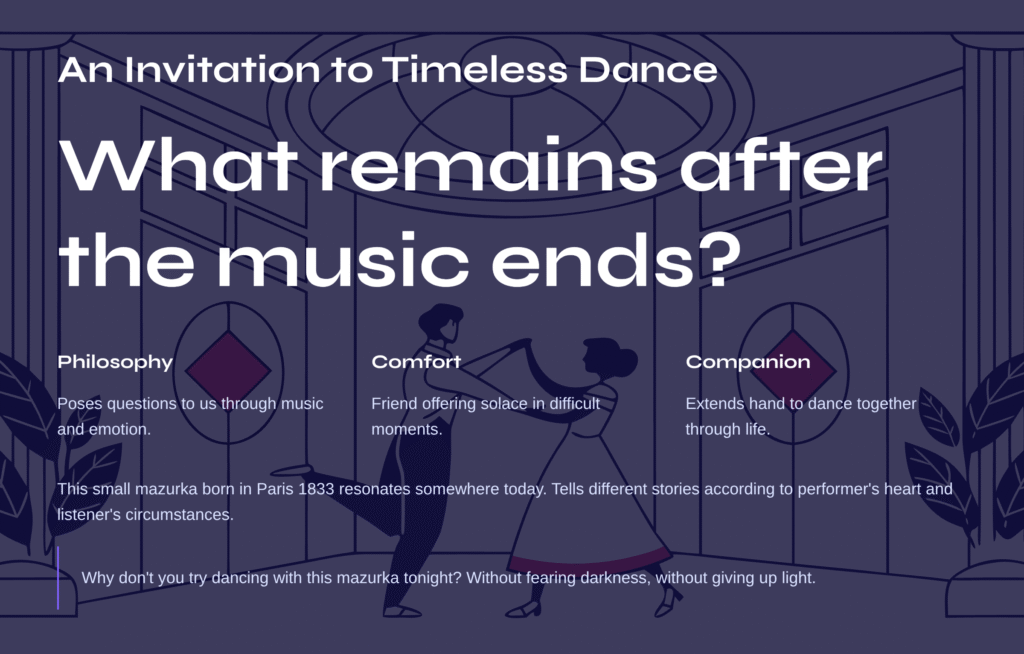
An Invitation to Timeless Dance
What remains after the music ends? Chopin’s Mazurka in A minor Op.17 No.4 is not merely an object of appreciation. It is a philosophy that poses questions to us, a friend offering comfort, and sometimes a companion extending a hand to dance together.
This small mazurka born in Paris in 1833 is probably resonating somewhere in the world today on a piano. Telling different stories each time according to the performer’s heart, according to the listener’s circumstances.
Why don’t you try dancing with this mazurka tonight? Without fearing the darkness, without giving up on the light, simply entrusting your heart to where the music leads. Then you’ll discover the real message Chopin wanted to convey to us.
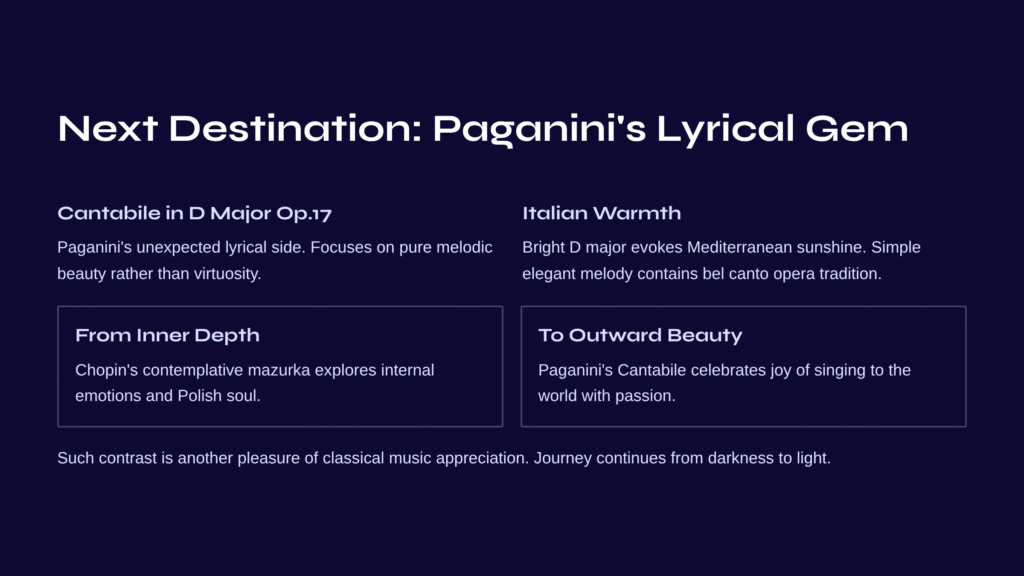
Next Destination: Paganini’s Lyrical Gem
Having experienced Chopin’s Polish lyricism, how about encountering Italy’s passionate warmth? Paganini’s Cantabile in D major Op.17 is a work containing the unexpected lyrical aspect shown by him who was called the devil of the violin.
When we think of Paganini, we usually imagine dazzling technique and fiery performances, but this Cantabile is completely different. True to its title “Cantabile” (meaning “in a singing style”), this piece focuses on pure melodic beauty rather than virtuosity. The violin sings like a human voice, sometimes whispering, sometimes confessing passionately.
If Chopin’s mazurka was inner contemplation, Paganini’s Cantabile is the joy of opening one’s heart wide and singing to the world. The bright, warm colors of D major evoke Mediterranean sunshine, while the simple yet elegant melody contains the tradition of Italian bel canto opera intact.
This piece is particularly important repertoire for violin students as well. It demonstrates the educational value of how beautiful music can be created without flashy technique, while being a perfect work for developing a performer’s musicality and expressiveness.
From Chopin’s inner depth to Paganini’s outward beauty—isn’t such contrast another pleasure of classical music appreciation?
